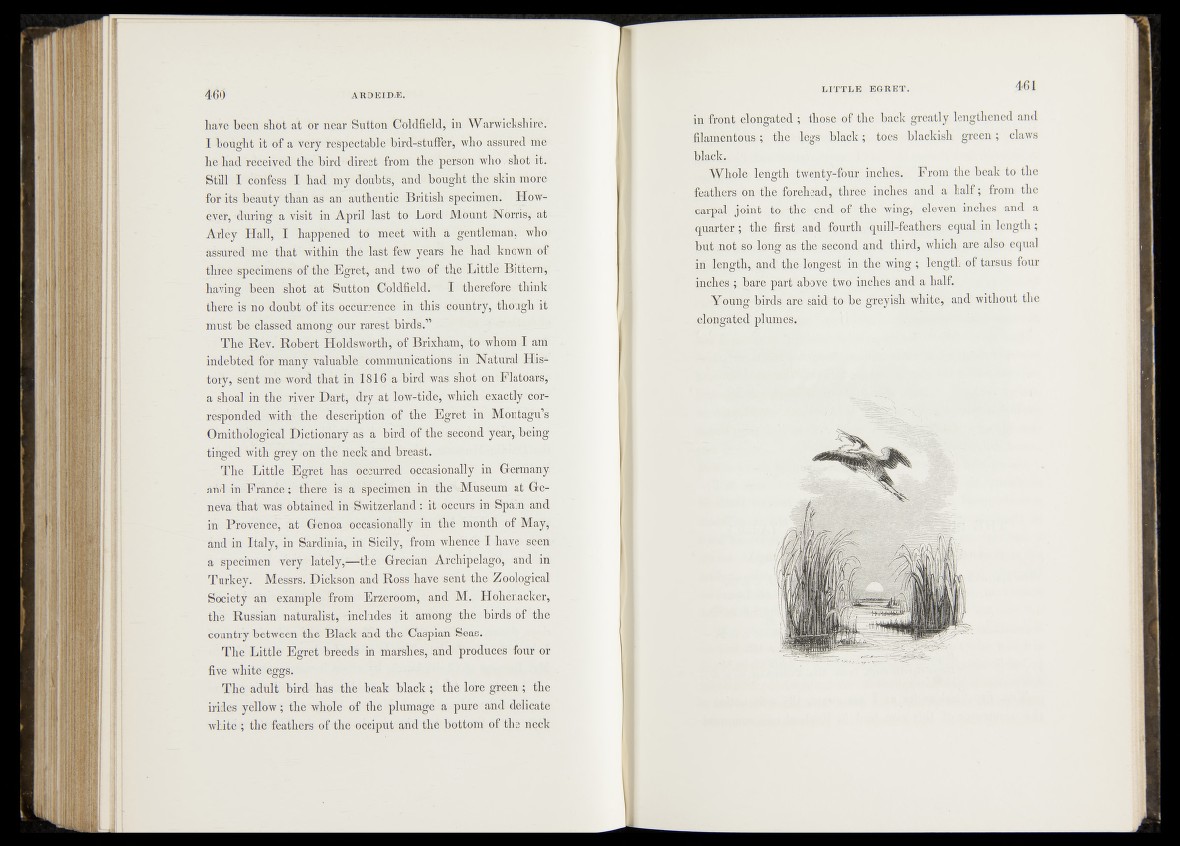
46Ó ARDEIDÆ.
havé been shot at or near Sutton Coldfield, in Warwickshire.'
I bought it of a very respectablfe-bird-stuffer, who assured ;rüè
hè had received the bird--direct froüCjt^er person who £shjpt<’it.
Still I confess I had my doubts, andihéught the skin moré
föï its beahty’ than as an authentic British specimen. How-
W m -during a v ^ p in April''lalt to Lord Mount ••Ni&rséÿ* at -
Alley Hall, I happened to meet with a génflemaü-, who
assured me that within thé dast few years' he had known of
thrëe Specimens of the Egret, and two of the Little Bittern;;
having been shot "àfr Sutton Coldfield. ‘ Î ’^therefore think
there is no doubt*’of its occurrence in this1 ^Ounhry, though it
must be classed among our rarest birds.”
The Rev. Robert Holdsworth, Of Brixham, -to whom I anii
indebted for many valuable. communlcatïOÖS^iiti Natural His4
toty, sént îne- word that in-1816 a bird was. shot-'«n^MatoatSy
a shoal in the “river Darty dry a t loW-tidej which exact] y ’oör-'
responded with the description of the Egret in Montagu’s
Ornithological Dictionary as a bird- of thefisecond yfear, being
tinged with grèÿ on the. neck and breast.
The Little -Egret has occurred occasionally'in Germany
and in France ; there is-a specimen in thëvMusèufn at Geneva*
that: was obtained indSwitierlarid : it öéckrs in Spaifttkttâ
in ProvenCd, at Genoa occasionally in thé month of May if
find in Italy, in Sardinia, in Sicily,;; from whence 1 -have see®
â Specimen very- lately,“ thé Grecian Archipelago* and in
Turkey. Messrs. Dickson and Ross have sent the Zoological
Society an example from Erzeroom, and 'M. Hohénacker,
the Russian naturalist, -includes it among the birds of the
country between the Black and the Caspian Seas.
The Little Egret breeds in marshes, and produces four oi*
five white eggs.
The adult bird has thé beak black ; thé lore green ; the
irides yellow ; the whole of the plumage a pure and delicate
white i the feathers of thé occiput and théîfebttOïn ofithe fièèl
L IT T L E EGRET. 4 6 1
in front elongated ; those of the back greatly lengthened and
filamentous; the dogs black; toes blackish green; claws
black.
Whole length twenty-four inches-., From the beak to the
,^ea%‘ers on thei;forehead, three inches, and a half; from the
carpal j|%it;^to, the^end, of the wing, eleven inches and a
quarter ^ ^h^|.first,and■>fourth quill-feathers equal in length;
but not-, so long as the second and third, which are also equal
in dength^ and' the longest- in tjhf§ wing ; length of tarsus four
■4n4heak'- bare- part above two inches and a half,
k^^odng birds* are-said* to b e greyish white, and without the
idon gated, plumes^*